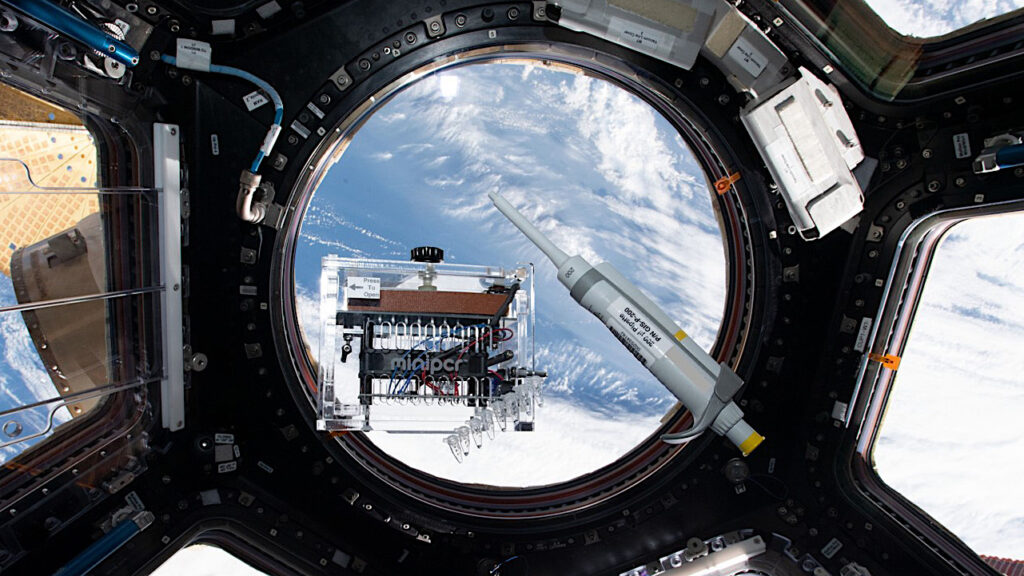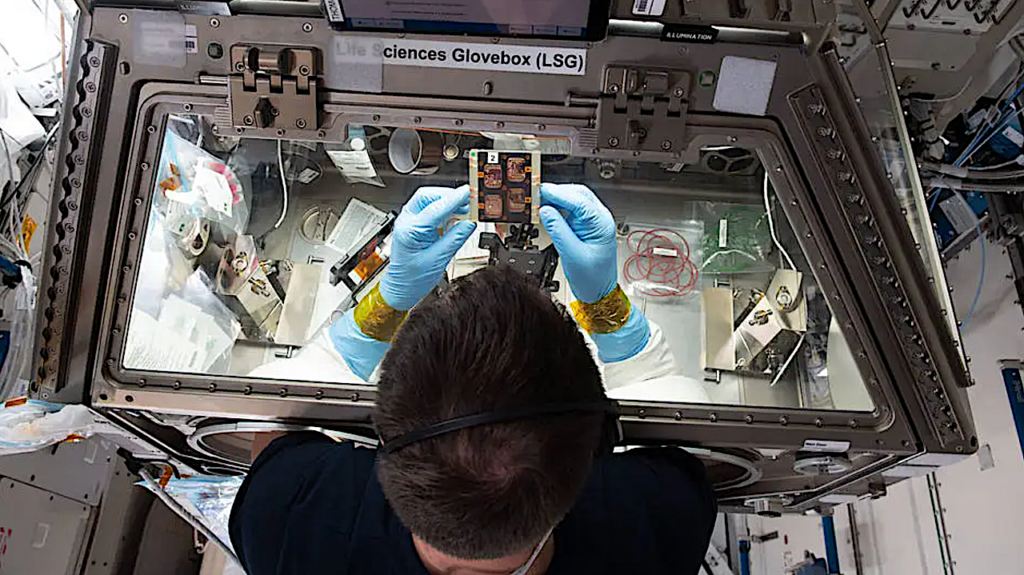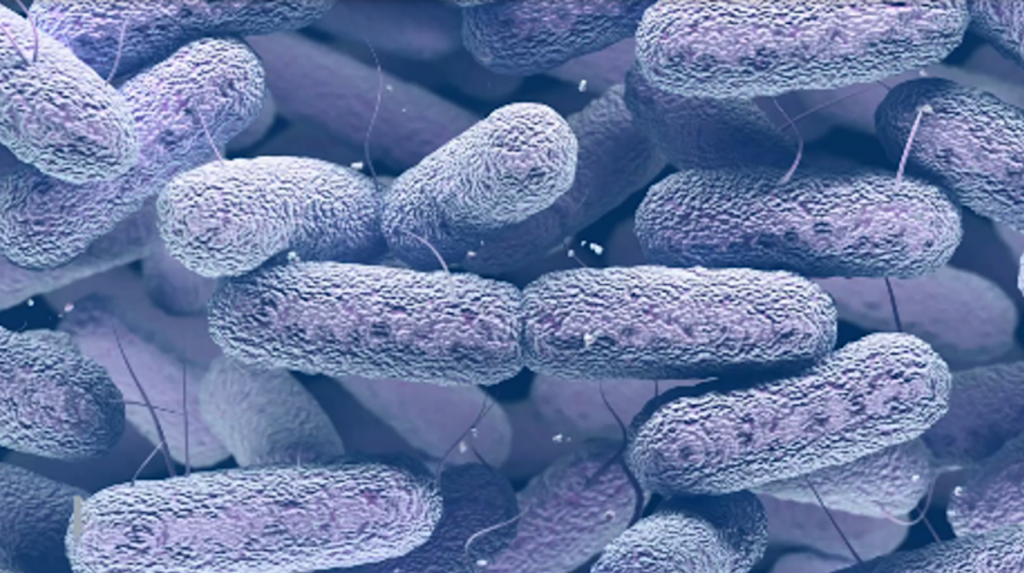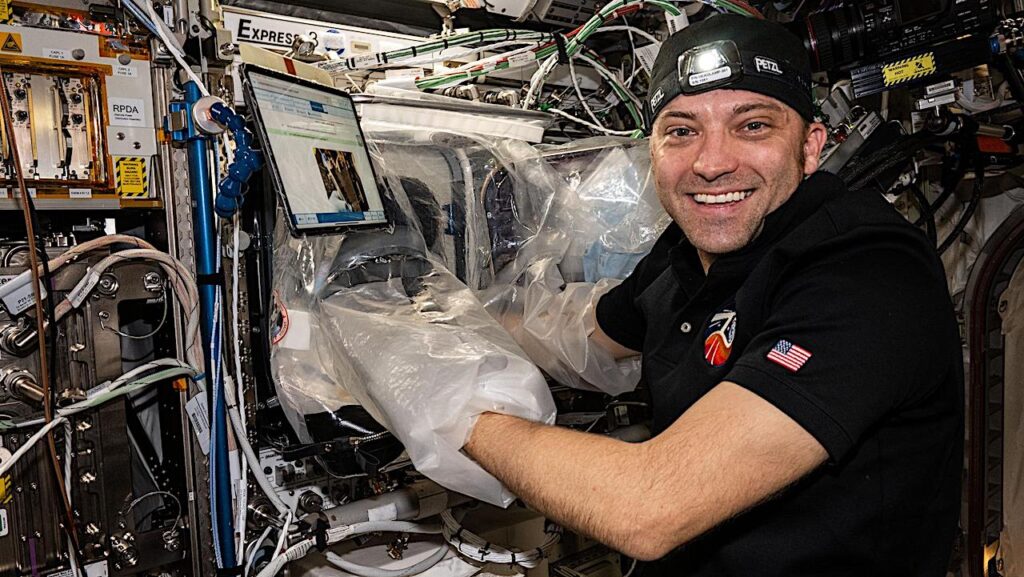NASA Spaceline Current Awareness List #1,064 1 September 2023 (Space Life Science Research Results)

View of tomatoes growing in the eXposed Root On-Orbit Test System (XROOTS) facility. NASA ID: iss068e018681 iss068e018681 (Oct. 25, 2022) – larger image
Papers deriving from NASA support:
- Land ES, Canaday E, Meyers A, Wyatt S, Perera IY.Bridging the gap: Parallel profiling of ribosome associated and total RNA species can identify transcriptional regulatory mechanisms of plants in spaceflight.J Plant Interact. 2023 Aug 28. Online ahead of print.PI: S. WyattNote: From the abstract: “As plants are an essential component of sustainable life support systems, long-duration space missions will require a sophisticated understanding of plant adaptations to spaceflight and microgravity. For many years, transcriptional profiling of steady state mRNA abundances has been used as measure of plant adaptations to the space environment. However, measured changes in transcript abundances are often not reflected in corresponding changes in the proteome due regulatory processes governing translation. Translating ribosome affinity purification (TRAP) is a technique that selectively targets ribosome bound mRNAs for isolation and downstream sequencing. Comparing profiles of ribosome-associated mRNAs with total mRNAs provides insight into the translatome and may more accurately inform on the cellular responses to the spaceflight environment. Toward that goal, this work describes a methodology developed ahead of the APEx-07 flight mission.” This article may be obtained online without charge.
Journal Impact Factor: 3.2
Funding: “Funding was partially provided by NASA Biological and Physical Sciences [grant #80NSSC19K1481] to S.E.W and I.P.” - Ong J, Waisberg E, Masalkhi M, Kamran SA, Lowry K, Sarker P, Zaman N, Paladugu P, Tavakkoli A, Lee AG.Artificial intelligence frameworks to detect and investigate the pathophysiology of spaceflight associated neuro-ocular syndrome (SANS).Brain Sci. 2023 Jul 30;13(8):1148. Review.PI: A. TavakkoliNote: This article is part of Special Issue “Recent Advances in Neuro-Opthalmology” (https://www.mdpi.com/journal/brainsci/special_issues/U149EB2R55). Additional articles will be forthcoming and may be found in the link to the Special Issue. This article may be obtained online without charge.
Journal Impact Factor: 3.3
Funding: “NASA Grant [80NSSC20K183]: A Non-intrusive Ocular Monitoring Framework to Model Ocular Structure and Functional Changes due to Long-term Spaceflight.” - Gaza R, Johnson AS, Hayes B, Campbell-Ricketts T, Rakkola J, Abdelmelek M, Zeitlin C, George S, Stoffle N, Castro A, Amberboy C, Semones E.The importance of time-resolved personal dosimetry in space: The ISS crew active dosimeter.Life Sci Space Res. 2023 Aug 25. Online ahead of print.Note: From the abstract: “Monitoring space radiation is of vital importance for risk reduction strategies in human space exploration. Radiation protection programs on Earth and in space rely on personal and area radiation monitoring instruments. Crew worn radiation detectors are crucial for successful crew radiation protection programs since they measure what each crewmember experiences in different shielding configurations within the space habitable volume. The Space Radiation Analysis Group at NASA Johnson Space Center investigated several compact, low power, real-time instruments for personal dosimetry. Following these feasibility studies, the Crew Active Dosimeter (CAD) has been chosen as a replacement for the legacy crew passive radiation detectors.”
Journal Impact Factor: 2.5
Funding: “This work was performed under NASA contract NNJ15HK11B.” - Kwiatkowski E, Suman S, Kallakury BVS, Datta K, Fornace AJ Jr, Kumar S.Expression of stem cell markers in high-LET space radiation-induced intestinal tumors in Apc1638N/+ mouse intestine.Cancers. 2023 Aug 24;15(17):4240.PI: A.J. Fornace Jr/NSCORNote: This article may be obtained online without charge.
Journal Impact Factor: 5.2
Funding: “This study was supported in part by National Aeronautics and Space Administration (NASA) Grant Numbers 80NSSC22K1279 and NNX15AI21G. The authors acknowledge the Lombardi Comprehensive Cancer Shared Resources (MSR), which are in part supported by award number P30CA051008 (P.I. Louis Weiner) from the National Cancer Institute.” - Tavakol DN, Nash TR, Kim Y, He S, Fleischer S, Graney PL, Brown JA, Liberman M, Tamargo M, Harken A, Ferrando AA, Amundson S, Garty G, Azizi E, Leong KW, Brenner DJ, Vunjak-Novakovic G.Modeling and countering the effects of cosmic radiation using bioengineered human tissues.Biomaterials. 2023 Oct;301:122267.PI: G. Vunjak-NovakovicJournal Impact Factor: 14
Funding: “We gratefully acknowledge the funding support of this work by the National Institutes of Health (EB027062, HL076485, CA249799 to G.V.- N.; U19-AI067773, 1S10OD025190 to D.J.B.; K99 CA267168 to J.A.B.; 1F31CA275733 fellowship to D.N.T.), the National Science Foundation (1644869 fellowship to D.N.T. and ERC16478 to G.V.-N.), the Empire State Development Corporation (AC710 to D.J.B), and the Translational Research Institute for Space Health (TRISH/NASA) agency for their support (RAD0104 and NNX16AO69A to G.V.-N., D.J.B., K.L.).” - Caston RA, Fortini P, Chen K, Bauer J, Dogliotti E, Yin YW, Demple B.Maintenance of flap endonucleases for long-patch base excision DNA repair in mouse muscle and neuronal cells differentiated in vitro.Int J Mol Sci. 2023 Aug 12;24(16):12715.Note: This article is part of Special Issue “Endogenous DNA Damage and Repair” (https://www.mdpi.com/journal/ijms/special_issues/416NG1LUQE). Additional articles will be forthcoming and may be found in the link to the Special Issue. This article may be obtained online without charge.
Journal Impact Factor: 5.6
Funding: “This research was funded by grants R21CA198752 and R21CA191856 from the U.S. National Cancer Institute (PI: B. Demple), National Aeronautics and Space Administration grants NNA14AB04A and 80NSSC19M0215 (P.I., Tim Glotch, Stony Brook University), and grant R01GM14925 from the U.S. National Institute of General Medical Sciences (P.I., Y.W.Y).” - Sander K, Abel AJ, Friedline S, Sharpless W, Skerker J, Deutschbauer A, Clark DS, Arkin AP.Eliminating genes for a two-component system increases PHB productivity in Cupriavidus basilensis 4G11 under PHB suppressing, nonstress conditions.Biotechnol Bioeng. 2023 Aug 28. Online ahead of print.Note: This article may be obtained online without charge.
Journal Impact Factor: 3.8
Funding: “National Aeronautics and SpaceAdministration, Grant/Award Number: NNX17AJ31G.” - Raber J, Sharpton TJ.Gastrointestinal dysfunction in neurological and neurodegenerative disorders.Semin Neurol. 2023 Aug 22. Online ahead of print.PI: J. RaberJournal Impact Factor: 2.7
Funding: PI reports NASA Task Book project “The Relation Between Cognitive Injury, Network Stability, and Epigenetic Change Following Exposure to Space Radiation” funding.
Other papers of interest:
- Kim BS, Alcantara AVJ, Moon JH, Higashitani A, Higashitani N, Etheridge T, Szewczyk NJ, Deane CS, Gaffney CJ, Higashibata A, Hashizume T, Yoon KH, Lee JI.Comparative analysis of muscle atrophy during spaceflight, nutritional deficiency and disuse in the nematode Caenorhabditis elegans.Int J Mol Sci. 2023 Aug 10;24(16):12640.Note: ISS results. This article is part of Special Issue “Cellular and Molecular Signaling Meet the Space Environment” (https://www.mdpi.com/journal/ijms/special_issues/Cellular_molecular_signaling_space). The Special Issue includes articles from Current Awareness lists #983 https://doi.org/10.3390/ijms23010075; #1,002 https://doi.org/10.3390/ijms23105593 and https://doi.org/10.3390/ijms23105489; #1,008 https://doi.org/10.3390/ijms23137465 and https://doi.org/10.3390/ijms23137133; #1,054 https://doi.org/10.3390/ijms24065955; and #1,058 https://doi.org/10.3390/ijms241311135. This article may be obtained online without charge.
- Shimizu R, Hirano I, Hasegawa A, Suzuki M, Otsuki A, Taguchi K, Katsuoka F, Uruno A, Suzuki N, Yumoto A, Okada R, Shirakawa M, Shiba D, Takahashi S, Suzuki T, Yamamoto M.Nrf2 alleviates spaceflight-induced immunosuppression and thrombotic microangiopathy in miceCommun Biol. 2023 Aug 25;6(1):875.Note: ISS results. This article may be obtained online without charge.
- Berkovich YA, Beliak AM, Bagretsova MR, Korshunov DV, Savostianova LI, Smolianina SO.Ways to improve the efficiency of artificial soil used for root crops cultivation in a space greenhouse.Aviakosm Ekolog Med. 2023;57(4):97-105. Russian.
- Berseneva AP, Funtova II.Prenosological diagnostics as a methodology of organism physiological condition assessment and its place in space and terrestrial medicine.Aviakosm Ekolog Med. 2023;57(4):5-19. Russian.Note: From the abstract: “A new concept of the doctrine of health—prenosological diagnosis—originated in space medicine. One of the founders of this doctrine was Roman Markovich Baevsky. This approach was built not on the diagnosis of diseases, but on the assessment of the quality of health with the allocation of four conditions: satisfactory adaptation; tension of adaptation mechanisms; unsatisfactory adaptation; and failure to adapt.”
- Izzo LG, El Nakhel C, Rouphael Y, Proietti S, Paglialunga G, Moscatello S, Battistelli A, Iovane M, Romano LE, De Pascale S, Aronne G.Applying productivity and phytonutrient profile criteria in modelling species selection of microgreens as space crops for astronaut consumption.Front Plant Sci. 2023 Aug 11;14:1210566.Note: From the abstract: “In this study we developed and applied an algorithm to objectively compare numerous genotypes of microgreens intending to select those with the best productivity and phytonutrient profile for cultivation in Space.” This article is part of Research Topic “Micro-Scale Vegetable Production: Sprouts and Microgreens as Innovative Functional Foods” (https://www.frontiersin.org/research-topics/51760/micro-scale-vegetable-production-sprouts-and-microgreens-as-innovative-functional-foods#overview) and may be obtained online without charge.
- Manzano A, Weging S, Bezdan D, Borg J, Cahill T, Carnero-Diaz E, Cope H, Deane CS, Etheridge T, Giacomello S, Hardiman G, Leys N, Madrigal P, Mastroleo F, Medina FJ, Mieczkowski J, Fernandez-Rojo MA, Siew K, Szewczyk NJ, Walsh SB, da Silveira WA, Herranz R.Enhancing European capabilities for application of multi-omics studies in biology and biomedicine space research.iScience. 2023 Sep 15;26(9):107289. Review.Note: This article may be obtained online without charge.
- Berardini M, Gesualdi L, Morabito C, Ferranti F, Reale A, Zampieri M, Karpach K, Tinari A, Bertuccini L, Guarnieri S, Catizone A, Mariggiò MA, Ricci G.Simulated microgravity exposure induces antioxidant barrier deregulation and mitochondria enlargement in TCam-2 cell spheroids.Cells. 2023 Aug 19;12(16):2106.Note: A random positioning machine was used in this study. This article is part of Special Issue “New Insights into Microgravity and Space Biology” (https://www.mdpi.com/journal/cells/special_issues/R75D12X7FZ). The Special Issue also includes articles from previous Current Awareness Lists #1,028 https://doi.org/10.3390/cells11233871; #1,032 https://doi.org/10.3390/cells12020246; #1,041 https://doi.org/10.3390/cells12050691 and https://doi.org/10.3390/cells12050734; and #1,061 https://doi.org/10.3390/cells12141907. This article may be obtained online without charge.
- De Micco V, Amitrano C, Mastroleo F, Aronne G, Battistelli A, Carnero-Diaz E, De Pascale S, Detrell G, Dussap CG, Ganigué R, Jakobsen ØM, Poulet L, Van Houdt R, Verseux C, Vlaeminck SE, Willaert R, Leys N.Plant and microbial science and technology as cornerstones to bioregenerative life support systems in space.npj Microgravity. 2023 Aug 24;9(1):69. Review.Note: This article may be obtained online without charge.
- Gallardo-Dodd CJ, Oertlin C, Record J, Galvani RG, Sommerauer C, Kuznetsov NV, Doukoumopoulos E, Ali L, Oliveira MMS, Seitz C, Percipalle M, Nikić T, Sadova AA, Shulgina SM, Shmarov VA, Kutko OV, Vlasova DD, Orlova KD, Rykova MP, Andersson J, Percipalle P, Kutter C, Ponomarev SA, Westerberg LS.Exposure of volunteers to microgravity by dry immersion bed over 21 days results in gene expression changes and adaptation of T cells.Sci Adv. 2023 Aug 25;9(34):eadg1610.Note: This article may be obtained online without charge.
- Golubkova MA, Ogneva IV.The content of cytoskeletal proteins, mrna of associated genes, and post-translational histone modifications in Drosophila melanogaster ovaries in the condition of simulated microgravity.Aviakosm Ekolog Med. 2023;57(4):71-7. Russian.
- Moroz GA, Kriventsov MA, Kutia SA.The effect of systematic gravitational overloads on the structural organization of the adrenals and thymus in an experiment.Aviakosm Ekolog Med. 2023;57(4):78-86. Russian.
- Supolkina NS, Shved DM, Yusupova AK, Gushchin VI, Ryumin OO.The main phenomena in cosmonauts’ communication within the crew mission control center communication system and the need for modifications.Aviakosm Ekolog Med. 2023;57(4):20-5. Russian.
- Ramey-Ward AN, Dong Y, Yang J, Ogasawara H, Bremer-Sai EC, Brazhkina O, Franck C, Davis M, Salaita K.Optomechanically actuated hydrogel platform for cell stimulation with spatial and temporal resolution.ACS Biomater Sci Eng. 2023 Aug 21. Online ahead of print.
- Naumova AA, Oleynik EA, Grigorieva YS, Nikolaeva SD, Chernigovskaya EV, Glazova MV.In search of stress: Analysis of stress-related markers in mice after hindlimb unloading and social isolation.Neurol Res. 2023 Aug 29;1-12.Note: Hindlimb unloading study.
- Puchkova AA, Shpakov AV, Baranov VM, Katuntsev VP, Stavrovskaya DM, Primachenko GK, Gorbachev VP, Tomilovskaya ES, Orlov OI.General results of the 21-day head-down bedrest study without the use of prophylaxis.Aviakosm Ekolog Med. 2023;57(4):31-41. Russian.Note: Head-down bedrest study.
- Versteeg N, Clijsen R, Hohenauer E.Effects of 3-week repeated cold water immersion on leukocyte counts and cardiovascular factors: An exploratory study.Front Physiol. 2023 Aug 29;14:1197585.Note: This article is part of Research Topic “Cold, heat and hypoxia as a medical tool: The use in a healthy and diseased population” (https://www.frontiersin.org/research-topics/48889/cold-heat-and-hypoxia-as-a-medical-tool-the-use-in-a-healthy-and-diseased-population#overview). The Special Issue also includes articles from previous Current Awareness Lists #1,050 https://doi.org/10.3389/fphys.2023.1173171 and #1,057 https://doi.org/10.3389/fphys.2023.1213733. This article may be obtained online without charge.
- Sobel AL, Orford R, Klingenberger K.The way ahead: Adaptive medical standards to optimize commercial space traveler health, safety, and performance.Front Space Technol. 2023 Aug 31;4:1155432.Note: This article is part of Research Topic “Fast Transit, Crew Health, and Performance on Extended Duration Space Missions” (https://www.frontiersin.org/research-topics/46048/fast-transit-crew-health-and-performance-on-extended-duration-space-missions#overview). The Research Topic also includes articles from previous Current Awareness Lists #1,053 https://doi.org/10.3389/fpubh.2023.1161124 and #1,058 https://doi.org/10.3389/fpubh.2023.1181911. This article may be obtained online without charge.








